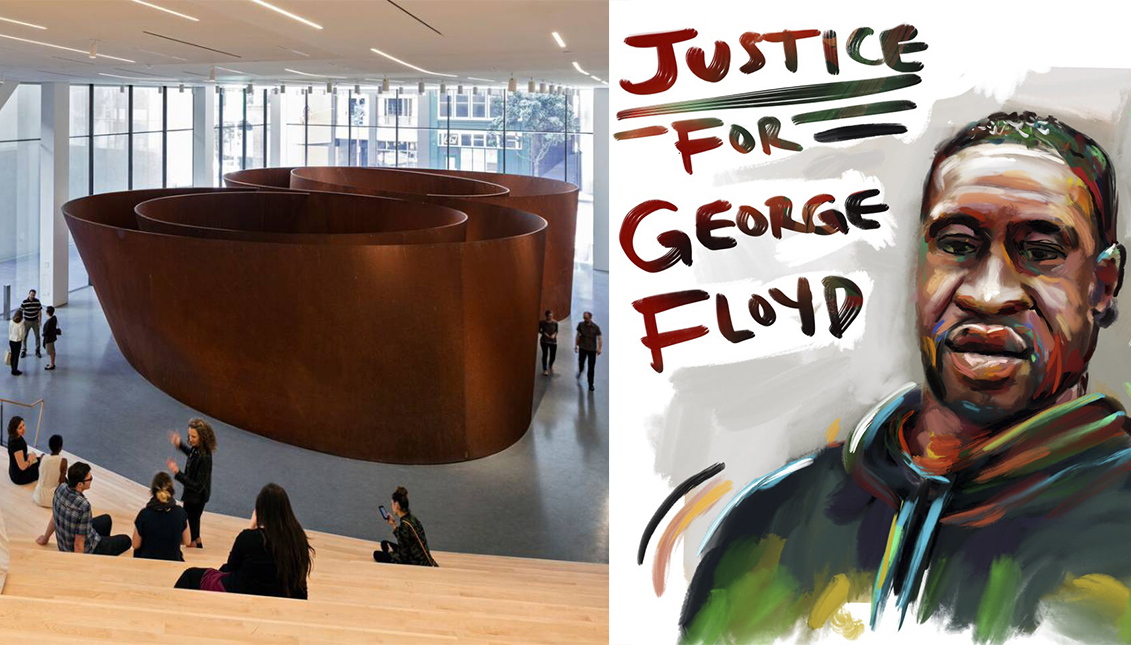
Museums under the spotlight for using black art as a "facade"
A former employee accused SFMOMA of snobbery and censorship after the museum hushed his comment on its soft reaction to George Floyd's death.
At a time when the United States is experiencing some of its biggest uprisings of recent memory, after years of oppression and normalized violence against black people, cultural institutions, as well as citizens, have launched a solidarity campaign and are making the work of black artists visible on social media.
However, wearing or sharing a slogan is not the same as being consistent with it. More facts and less talk, some say. This has sparked a heated debate about the real efforts of some museums not only to make black art visible but to respect and listen to their employees of color.
The controversy erupted last Saturday, May 30, when the San Francisco Museum of Modern Art (SFMOMA) published a silk-screen print by artist Glenn Ligon on the 1995 Million Man March, led by Louis Farrakhan of Nation of Islam. Hyperallergic recalled that on that occasion, the march was criticized for excluding women.
The image was replaced at once by a quote from Ligon that read: "Why do we need to raise our hands in that symbolic space again and again and again to be present in this country?"
A former marketing employee, Taylor Brandon, criticized the museum for its vague stance in a comment on a post regarding the death of George Floyd and the racial inequities in the U.S.
"This is an evasion," Brandon wrote. "Using black art/artist to make a statement that must come from the institution. Not only can black artists be amplified during a wave of black mourning and grief. Having black people on the web or in the feed is not enough."
The former employee went further and examined some of the museum's executives, whom she accused of being "beneficiaries of racism."
Instead of giving a formal response, SFMOMA removed the comments from the post, sparking a debate that Brandon described in an interview with Hyperallergic as "total censorship," as well as pointing out that not everything that glitters in the institution's backroom is gold. Brandon's claim is something that another anonymous museum employee has since endorsed.
"I'm very disappointed, though not surprised, by SFMOMA's response to the criticism they received over the weekend," said the other employee who preferred not to reveal their identity, and who noted that the museum winks at its black employees, while on the other hand trying to "silence" them and not really taking them into account.
"What happened with the Instagram post highlights the inability of leadership to recognize racism within the museum among employees and donors," they added.
SFMOMA responded to the controversy by reopening comments in its original post and publishing an official statement apologizing for and expressing its sadness and outrage at the trauma and violence suffered by African-Americans.
"We apologize," they wrote. "We recognize that African Americans and communities of color are especially impacted and suffering at this time." In regards to Brandon's comments, they stated that it wasn't censorship, but that they violated Instagram regulations, particularly because of his allusions to members in leadership positions within the institution.
Brandon replied that everything she had said was completely true. Her departure from the museum last March, she claimed, had to do with the same issue: the worker had complained that her supervisors had not devoted enough resources to a recent exhibition on photographer Dawoud Bey compared to the funds devoted to an Andy Warhol retrospective.
"They didn't listen to me," she added. "I felt totally silenced."
RELATED CONTENT
Many Instagram users have joined Taylor Brandon in criticizing the silencing of Black voices, and even the SFMOMA union has shown its support for free speech, saying, "Censorship is racist!
"Non-Black art people are beginning to speak out and protect Black people," the union continued. "People are about to get fired, so what are you protecting... not a job."
In an act of constraint, SFMOMA published a statement yesterday on Instagram on behalf of artists Leila Weefur and Elena Gross expressing their "principled disagreement" with the museum.
"The SFMOMA's apology does not acknowledge that their act of censorship, by deleting and disabling comments from their May 30 post, is an act of silencing that is complicit in and allows for systemized violence against black individuals," they wrote.
SFMOMA is not the only museum that has been challenged for not openly declaring its support for the black community and its rejection of racism.
Both the J. Paul Getty Museum in Los Angeles and the Metropolitan Museum of Art in New York have been heavily criticized for not standing up clearly and have had to apologize.
"Museums create this facade of being pro-Black artists, but they're not really," Brandon said.
She also pointed out that it is often the black employees themselves who fight to give artists of color the attention they deserve.
"They're the ones sticking their necks out," she said.











LEAVE A COMMENT: